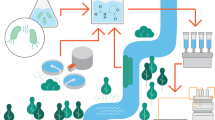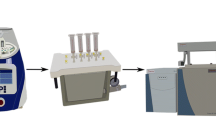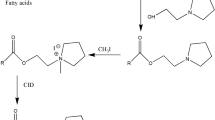Abstract
A challenge for understanding the role of bacterial cell–cell signalling in the environment is the detection of those signals, which are often present in low (nmol L−1) concentrations. We describe here a simple purification method, solid-phase extraction (SPE), for increasing the sensitivity of detection for one such group of signals, acyl homoserine lactones (AHLs), in environmental samples. Spiking of dried marine sponge tissue (Stylinos sp.) with AHLs resulted in detection down to 0.01 ppm for 3-oxo-hexanoyl homoserine lactone (3-oxo C6-HSL) and 1 ppm for hexanoyl homoserine lactone (C6-HSL). Compared with liquid extraction methods use of SPE resulted in twofold and tenfold improvements in sensitivity, respectively.



Similar content being viewed by others
References
Fuqua C, Parsek MR, Greenberg EP (2001) Annu Rev Genet 35:439–468
Whitehead NA, Barnard AML, Slater H, Simpson NJL, Salmond GPC (2001) Microbiol Rev 25:365–404
Cha C, Gao P, Chen YC, Shaw PD, Farrand SK (1998) Mol Plant Microbe In 11:1119–1129
Gram L, Grossart HP, Schlingloff A, Kiorboe T (2002) Appl Environ Microbiol 68:4111–4116
Gram L, Christensen AB, Ravn L, Molin S, Givskov M (1999) Appl Environ Microbiol 65:3458–3463
Zhu H, Thuruthyil SJ, Willcox MDP (2001) Clin Exp Ophthalmol 29:150–152
McLean RJC, Whiteley M, Stickler DJ, Fuqua WC (1997) FEMS Microbiol Lett 154:259–26
Stickler DJ, Morris NS, McLean RJC, Fuqua C (1998) Appl Environ Microbiol 64:3486–3490
Vincke E, Boon N, Verstraete W (2001) Appl Microbiol Biotechnol 57:776–785
Boettcher KJ, Ruby EG (1995) J Bacteriol 177:1053–1058
Shaw PD, Ping G, Daly SL, Cha C, Cronan JE Jr, Rinehart KL, Farrand SK (1997) P Natl Acad Sci USA 94:6036–6041
Erickson DL, Nsereko VL, Morgavi DP, Selinger LB, Rode LM, Beauchemin KA (2002) Can J Microbiol 48:374–378
Piedra LA, Tejedor MD, Hernando A, Aguera D, Barcelo Fernandez-Alba A (2000) Chromatographia 52:631–638
Geerdink RB, Niessen WMA, Brinkman UAT (2002) J Chromatogr A 970:65–93
Farre M, Barcelo D (2003) Trac-Trend Anal Chem 22:299–310
Frommberger M, Schmitt-Kopplin P, Ping G, Frisch H, Schmid M, Zhang Y, Hartmann A, Kettrup A (2004) Anal Bioanal Chem 378:1014–1020
Taylor MW, Schupp PJ, Baillie HJ, Charlton TS, de Nys R, Kjelleberg S, Steinberg PD (2004) Appl Environ Microb 70:4387–4389
Fuqua C, Winans SC (1996) J Bacteriol 178:435–440
Srinivasan S, Ostling J, Charlton T, de Nys R, Takayama K, Kjelleberg S (1998) J Bacteriol 180:201–209
Charlton TS, de Nys R, Netting A, Kumar N, Hentzer M, Givskov M, Kjelleberg S (2000) Environ Microbiol 2:530–541
Zhu J, Chai YR, Zhong ZT, Li SP, Winans SC (2003) Appl Environ Microbiol 69:6949–6953
Andersen JB, Heydorn A, Hentzer M, Eberl L, Geisenberger O, Christensen BB, Molin S, Givskov M (2001) Appl Environ Microbiol 67:575–585
Kaplan HB, Greenberg EP (1985) J Bacteriol 163:1210–1214
Williams P, Bainton NJ, Swift S, Chhabra SR, Winson MK, Stewart GSAB, Salmond GPC, Bycroft B (1992) FEMS Microbiol Lett 100:161–168
Chernin LS, Winson MK, Thompson JM, Havan S, Bycroft BW, Chet I, Williams P, Stewart GSAB (1998) J Bacteriol 180:4435–4441
Acknowledgements
This work was supported by a Feodor-Lynen-Fellowship from the Alexander-von-Humboldt Foundation to P. Schupp and Australian post-graduate scholarships to T. Charlton and M. Taylor, which are gratefully acknowledged.
Author information
Authors and Affiliations
Corresponding author
Rights and permissions
About this article
Cite this article
Schupp, P.J., Charlton, T.S., Taylor, M.W. et al. Use of solid-phase extraction to enable enhanced detection of acyl homoserine lactones (AHLs) in environmental samples. Anal Bioanal Chem 383, 132–137 (2005). https://doi.org/10.1007/s00216-005-3387-x
Received:
Revised:
Accepted:
Published:
Issue Date:
DOI: https://doi.org/10.1007/s00216-005-3387-x




